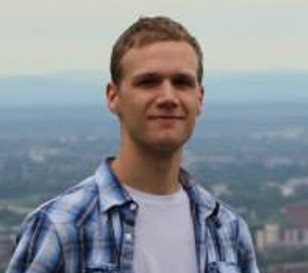Trace: » tsikourasa
This is an old revision of the document!

Anthony Tsikouras
Postdoctoral Researcher in Engineering Physics
Ph.D. in Engineering Physics, McMaster University
Bachelors in Engineering Physics (Photonics), McMaster University
Email: tsikoua@mcmaster.ca
Office/Lab: ETB/306
Phone: (905) 902-3897
Research
Compared to widefield imaging, confocal microscopy is able to detect finer details in thick samples by blocking the contributions from out-of-focus fluorophores, therefore allowing for optical sectioning. Performing a traditional laser-scanning confocal scan requires either a long integration time, or high excitation light fluence that can be damaging to biological samples. In order to acquire a confocal scan that is both fast and gentle, the process must be multiplexed, with the sample being interrogated by a large array of excitation foci with low individual optical power. The most common implementation of multi-point confocal uses a pair of spinning disks patterned with microlenses and pinholes, respectively, where a fraction of a turn of the spinning disk unit is enough to sweep the foci across the entire sample. At present, spinning disk confocal is by far the most commonly used implementation of confocal microscopy for high-throughput imaging applications, due to its high acquisition speed and gentle light levels without significant sacrifices to image quality.
The spinning method for scanning, however, does not allow for the returning emission light to be “descanned” to a discrete detector - as a traditional mirror galvo scanner would. Instead, the emission light is scanned across an imaging detector in order to produce the reconstruction. This limits its choice of detector to those that can be implemented into a dense imaging array
Fluorescence imaging typically involves tagging components of a sample with matched fluorophores, then measuring the fluorescence intensity of the sample when it is stimulated with an excitation source. Fluorescence lifetime imaging microscopy (FLIM) is a technique whereby the decay time of a fluorescence signal is used, instead of its intensity. While this adds a layer of complexity and cost, it can be a much more reliable method of obtaining information about the the cell's microenvironment. For instance, when a fluorophore is in close proximity to another molecule, Förster resonant energy transfer (FRET) occurs. In the FRET process, a fluorophore transfers its energy (which would normally be fluoresced) to the nearby molecule. This acts to quench the fluorescence lifetime, causing it to be shorter than the fluorophore's usual lifetime decay. Measuring the lifetime of the fluorophore can then be an excellent indicator of protein-protein interaction.
I am prototyping a high-throughput high content microscope system that implements FLIM for use in drug discovery systems. The system is being optimized for speed to match high-throughput standards, as well as high spatial and temporal resolution.
Publications
Tsikouras, A., Peronio, P., Rech, I., Hirmiz, N., Deen, M.J., Fang, Q. (2016) Characterization of SPAD array for multifocal high-content screening applications, MDPI Photonics, 3, 56.
Tsikouras, A., Berman, R., Andrews, D.W., Fang, Q. (2015) High-speed multifocal array scanning using refractive window tilting, Biomedical Optics Express. 6: 3737-3747
Tsikouras, A., Ning, J., Ng. S., Sinclair, P., Berman, R., Andrews, D.W., Fang, Q. (2012) Streak camera crosstalk reduction using a multiple delay optical fiber bundle. Optics Letters. 37: 250-252.
Conference Presentations
Tsikouras, A. (2014), “Designing a scanning system for multiplexed confocal FLIM microscopy using refractive window tilting,” Society of Biomolecular Imaging and Informatics 1.
Tsikouras, A., Yeh, S.C., Fang, Q. (2014), “Instrumentation design for high-speed FLIM for applications in high-content screening,” Electrochemical Society Meeting 225, 1487.
Tsikouras, A., Ning, J., Ng. S., Sinclair, P., Berman, R., Andrews, D.W., Fang, Q. (2012), High-throughput FLIM-FRET nanoimaging for quantification of protein-protein interactions in high-content screening [oral presentation]. SPIE Optics + Photonics (conference). 8460-04.
Schedule
Spring 2013 Plan
Summer 2014 Plan
Upcoming Plan
Planning Stage
| Monday | Tuesday | Wednesday | Thursday | Friday | |
|---|---|---|---|---|---|
| 7:30am | |||||
| 8:30am | |||||
| 9:30am | |||||
| 10:30am | |||||
| 11:30am | |||||
| 12:30pm | |||||
| 1:30pm | |||||
| 2:30pm | |||||
| 3:30pm | Lab Meeting | ||||
| 4:30pm | |||||
| 5:30pm | |||||
| 6:30pm | |||||
| 7:30pm | |||||
| 8:30pm |
Courses taken:
| Course | Description | Semester |
|---|---|---|
| BME 701 | Biomedical Engineering Core I | 2010/2011 Term 1 |
| BME 706 | Biomedical Engineering Core II | 2010/2011 Term 2 |
| ECE 762 | Detection and Estimation Theory | 2011/2012 Term 1 |
| CSE 701 | Foundations of Modern Scientific Programming | 2013/2014 Term 1 |
| CE 6TN4 | Image Processing | 2013/2014 Term 2 |
| BME 707 | Advanced Topics in Biophotonics | 2014/2015 Term 1 |
Safety Training
| Base Courses | Additional Courses | ||
|---|---|---|---|
| Course | Date | Course | Date |
| WHMIS | 2009 | WHMIS Update | 2016/10 |
| Fire Safety | 2009 | Fire Safety update | 2016/10 |
| Biosafety 2 | 2011 | BSL-2 update | 2016/10 |
| Laser Safety | 2009 | Laser Safety Lecture | 2010 |
| Asbestos Awareness | 2009 | Emergency Code Procedures | 2013/09 |
| Ergonomics | 2016/10 | Chemical Handling | 2016/10 |
| Slips/Trips/Falls | 2016/10 | ||
| Eng Phys Safety | 2009 | ||
| Electrical Safety Awareness I | 2012 | ||
| Violence and Harrasssment | 2016/10 | ||
Related Links
You are here: start » people » tsikourasa